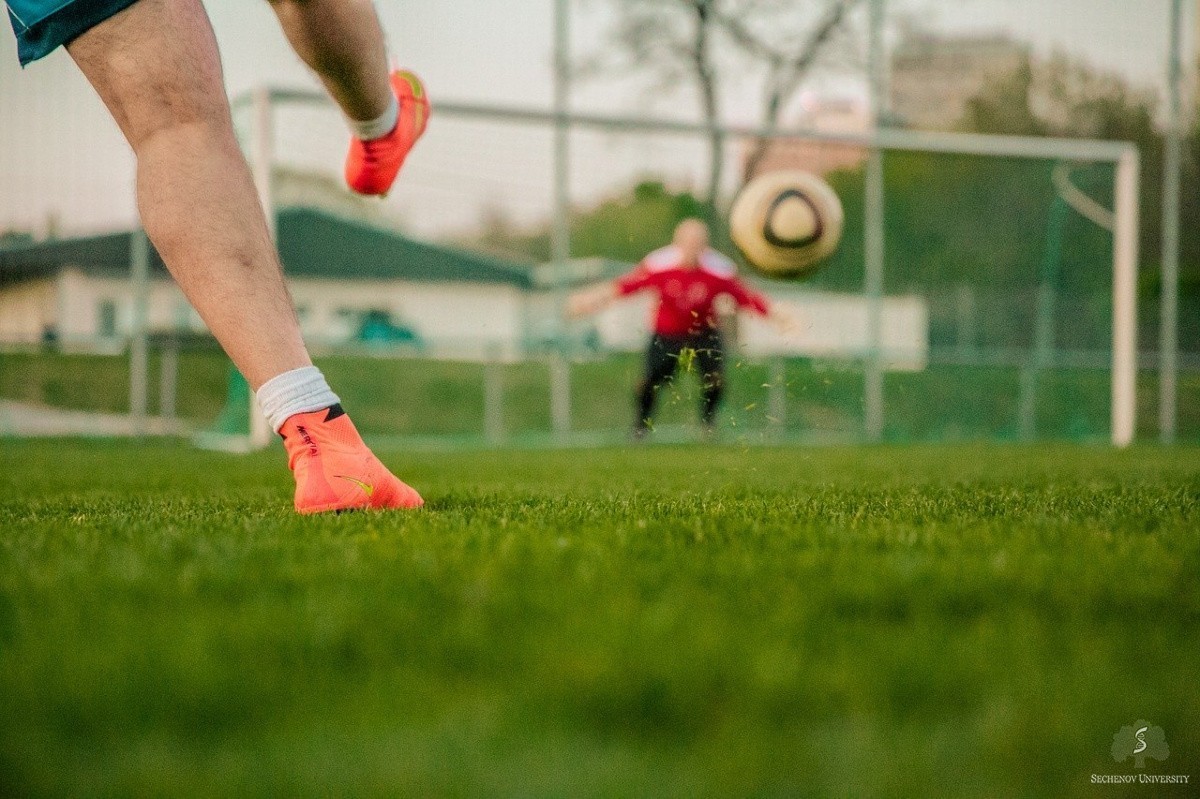Абитуриенту
- Абитуриенту
-
Обучающемуся
- Я – профессионал
- Локальные нормативные акты
- Образовательные программы
- Стоимость обучения
- Университет - обучающемуся
- Центр карьеры
- Учебный центр по маркировке
- Учеба и наука
- Школы мастерства
- Комфортная среда обучения
- Образовательные стандарты
- Стипендии и материальная поддержка
- Вакантные места
- Общежития
- Сотруднику
- Аккредитация специалистов
-
About University
- Mission & Brand Strategy
- University Leadership
- Rector's Welcome
- History
- Regulatory Documents
- Contacts
- Staff
- International Recruitment
- Partners
Applicants- Why Sechenov University
- Degree Programmes in English
- Preparatory Courses
- Non-Degree Programmes
- Transfer from other Institutions
07.07.2020Football players: which leg gets injured the most?
 Sechenov University study finds no difference whether leg dominant or not.
Sechenov University study finds no difference whether leg dominant or not.
Football is one of the most popular team sports in the world, and millions of people play it at a professional, semi-professional, or amateur level. Football’s popularity results in a significant number of injuries during the game which require medical attention. What doctors often see in such patients are the knee joint traumas.
Like people who have a dominant hand, the footballers, too, prefer to use one leg more than the other. The leg that is used more frequently for kicking the ball is called dominant, and the other one is non-dominant.
For professional football players, the injury rate usually depends on their age and career duration. Sechenov University scientists and co-authors examined 47 professional footballers, aged between 19 and 31, and analysed the condition of articular cartilage and meniscus of their legs—dominant and non-dominant. As a result, no significant difference was found between the injury severity for the legs that experienced different mechanical load. The work was published in Sports Medicine—Open, a leading research journal in the field.
The authors of the study evaluated the prevalence and severity of joint damage among athletes, but some footballers were excluded from the analysis: goalkeepers; those who previously underwent knee surgery; people who suffered a knee injury in the past three months; and those who experienced joint pain at the time of the examination.
Study participants were divided into two groups: athletes who played soccer for more than 20 years, and the less experienced ones. Magnetic resonance imaging (MRI) was used to examine the joints. This method produces high-resolution images of joint structures, which help evaluate changes in bones and cartilage tissues.
One of the findings was that all players had asymptomatic cartilage or meniscus damages. Clearly, their involvement in sports affected their knee joints. Most interestingly, the joints in the dominant and non-dominant legs were found to be in identical conditions.
Artemii Lazarev, one of the study authors, is a student at the Faculty of Medicine, Sechenov University. According to him, the study had found a lot of injuries without manifestation, and surgery had negatively affected professional performance and the progression of osteoarthritis. “No wonder many well-known sports medicine specialists say that the best surgery is the surgery that did not take place,” notes Artemii Lazarev.
The authors hope that their findings will help evaluate the impact of age, experience, and leg dominance on the knee joints in footballers, and sports medicine will focus on injury prevention and diagnostics to improve the health of professional sportsmen and sportswomen.
Read more: Bezuglov, E.N., Khaitin, V.Y., Lyubushkina, A.V. et al. The Effect of Training Experience and Leg Dominance on the Prevalence of Asymptomatic Intraarticular Changes of the Knee Joints in Adult Professional Male Soccer Players. Sports Med - Open 6, 19 (2020). https://doi.org/10.1186/s40798-020-00248-9
Photo Credit: Pixabay 1274661Embed on website
Football players: which leg gets injured the most?
Sechenov University study finds no difference whether leg dominant or not.
Football is one of the most popular team sports in the world, and millions of people play it at a professional, semi-professional, or amateur level. Football’s popularity results in a significant number of injuries during the game which require medical attention. What doctors often see in such patients are the knee joint traumas.
Like people who have a dominant hand, the footballers, too, prefer to use one leg more than the other. The leg that is used more frequently for kicking the ball is called dominant, and the other one is non-dominant.
For professional football players, the injury rate usually depends on their age and career duration. Sechenov University scientists and co-authors examined 47 professional footballers, aged between 19 and 31, and analysed the condition of articular cartilage and meniscus of their legs—dominant and non-dominant. As a result, no significant difference was found between the injury severity for the legs that experienced different mechanical load. The work was published in Sports Medicine—Open, a leading research journal in the field.
The authors of the study evaluated the prevalence and severity of joint damage among athletes, but some footballers were excluded from the analysis: goalkeepers; those who previously underwent knee surgery; people who suffered a knee injury in the past three months; and those who experienced joint pain at the time of the examination.
Study participants were divided into two groups: athletes who played soccer for more than 20 years, and the less experienced ones. Magnetic resonance imaging (MRI) was used to examine the joints. This method produces high-resolution images of joint structures, which help evaluate changes in bones and cartilage tissues.
One of the findings was that all players had asymptomatic cartilage or meniscus damages. Clearly, their involvement in sports affected their knee joints. Most interestingly, the joints in the dominant and non-dominant legs were found to be in identical conditions.
Artemii Lazarev, one of the study authors, is a student at the Faculty of Medicine, Sechenov University. According to him, the study had found a lot of injuries without manifestation, and surgery had negatively affected professional performance and the progression of osteoarthritis. “No wonder many well-known sports medicine specialists say that the best surgery is the surgery that did not take place,” notes Artemii Lazarev.
The authors hope that their findings will help evaluate the impact of age, experience, and leg dominance on the knee joints in footballers, and sports medicine will focus on injury prevention and diagnostics to improve the health of professional sportsmen and sportswomen.
Read more: Bezuglov, E.N., Khaitin, V.Y., Lyubushkina, A.V. et al. The Effect of Training Experience and Leg Dominance on the Prevalence of Asymptomatic Intraarticular Changes of the Knee Joints in Adult Professional Male Soccer Players. Sports Med - Open 6, 19 (2020). https://doi.org/10.1186/s40798-020-00248-9
Photo Credit: Pixabay 1274661



